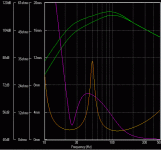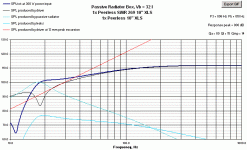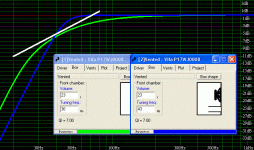I'm currently designing a sub which rolls off 8db from 100Hz to 20Hz but I want to alter the design to account for room gain. I'd like to use a generic transfer function that I could use to at least guess-attempt a flat in-room response.
Eg. 6db/octave below 80Hz, for a room approx. 4m x 3m x 2.5m?
I think even a crude approximation would be helpful.
Or since the transfer function is a result of the room dimensions (and volume?), does someone have a fomula to calculate it?
Eg. 6db/octave below 80Hz, for a room approx. 4m x 3m x 2.5m?
I think even a crude approximation would be helpful.
Or since the transfer function is a result of the room dimensions (and volume?), does someone have a fomula to calculate it?
Post #10 here gives a graph for average room gain. I will have to look up the original website I got it from, but here it is:
http://www.diyaudio.com/forums/showthread.php?postid=88719#post88719
One of our members, Serow, has made a file that can be added to Subwoofer Simulator, a loudspeaker modelling program written by our own F4ier, to display a louspeaker response with and without room gain. I'll dig up the post for Serow's file, if you like.
http://www.diyaudio.com/forums/showthread.php?postid=88719#post88719
One of our members, Serow, has made a file that can be added to Subwoofer Simulator, a loudspeaker modelling program written by our own F4ier, to display a louspeaker response with and without room gain. I'll dig up the post for Serow's file, if you like.
Just for the heck of it, here is a simulation of a Peerless XLS 12" , (3.5 ohm Re), in a 1 cu ft box tuned to 25 Hz. 28.3 volts driven, (app 200 watts for a 4 ohm speaker). This simulation program is Subwoofer Simulator with Serow's room gain file added.
Upper green line is response with room gain.
Lower green line is response without room gainl
Orange line is impedance.
Purple line is cone excursion.
Upper green line is response with room gain.
Lower green line is response without room gainl
Orange line is impedance.
Purple line is cone excursion.
Attachments
According to that graph, a crude transfer function is 2db/octave, and my anaechonic design averages 3.3 db/octave below 100Hz which means that, although not perfect, it helps a bit in flattening out the overall FR.
KW, funnily enough, I'm designing for a 10" XLS and 1 passive.
Bill, I'm well aware, but better to have some approximation included in the design then none at all, as room gain will always be apparent.
I'd love a function on how to calcuate the gain based on dimensions...
KW, funnily enough, I'm designing for a 10" XLS and 1 passive.
Bill, I'm well aware, but better to have some approximation included in the design then none at all, as room gain will always be apparent.
I'd love a function on how to calcuate the gain based on dimensions...
Attachments
Absolutely. Which room the the sub is in, where in the room, and where the listener is in the room will have huge effects.
This is just an average. Any real world setup is likely to vary from that by quite a bit.
Anyway, this is F4ier's site to download Subwoofer Simulator:
http://www.geocities.com/f4ier/speaker.htm
This is Serow's post to download the room gain file:
http://www.diyaudio.com/forums/showthread.php?threadid=21676&highlight=
This is just an average. Any real world setup is likely to vary from that by quite a bit.
Anyway, this is F4ier's site to download Subwoofer Simulator:
http://www.geocities.com/f4ier/speaker.htm
This is Serow's post to download the room gain file:
http://www.diyaudio.com/forums/showthread.php?threadid=21676&highlight=
Post #10 here gives a graph for average room gain. I will have to look up the original website I got it from, but here it is:
Hi KC,
correct me if I'm wrong, but that graph and other similar graphs
are related to compact loudspeakers optimally sited in free space
away from walls, derived from an article by Martin Colloms.
http://www.stereophile.com/features/44/index3.html
Adire Audio use a different room gain curve, in their
subwoofer white papers from where I don't know.
Yes, it appears the ultimate source of that chart is Martin Colloms, as I just discovered.
Here is the link to the article:
http://www.speakerbuilding.com/content/1020/page_3.php
Here is another thread where this is discussed:
http://www.diyaudio.com/forums/showthread.php?threadid=1261&highlight=Room+Gain+chart
I know Pyle tech help uses a different chart as well-one which gives greater boost. But as is generally agreed, whatever you get is just an average anyway.
Here is the link to the article:
http://www.speakerbuilding.com/content/1020/page_3.php
Here is another thread where this is discussed:
http://www.diyaudio.com/forums/showthread.php?threadid=1261&highlight=Room+Gain+chart
I know Pyle tech help uses a different chart as well-one which gives greater boost. But as is generally agreed, whatever you get is just an average anyway.
Vikash said:
KW, funnily enough, I'm designing for a 10" XLS and 1 passive.
I'd love a function on how to calcuate the gain based on dimensions...
Ten inch or twelve inch passive?
You know, I have an article by Roy Allison here where he took one loudspeaker and put it in different rooms and measured the curves. I can scan it and send it to anyone interested.
I believe they use LspCAD to calculate room gainAdire Audio use a different room gain curve, in their
subwoofer white papers from where I don't know.
According to my simulation program, which has a lower limit of 20Hz, a sealed system with an F3 of 50Hz and a Qts of .5 is almost exactly compensated for by room gain with a variety or reasonable room sizes and a variety of reasonable listening positions.
Changing the speaker to vented, F3 at 30Hz, shows a 6db bump in response at about 32Hz.
Further support, IMO, for low Q sealed systems.
Changing the speaker to vented, F3 at 30Hz, shows a 6db bump in response at about 32Hz.
Further support, IMO, for low Q sealed systems.
Bill Fitzpatrick said:According to my simulation program, which has a lower limit of 20Hz, a sealed system with an F3 of 50Hz and a Qts of .5 is almost exactly compensated for by room gain with a variety or reasonable room sizes and a variety of reasonable listening positions.
Changing the speaker to vented, F3 at 30Hz, shows a 6db bump in response at about 32Hz.
Further support, IMO, for low Q sealed systems.
Whilst i don't disagree with your findings overdamped bass
reflexes can emulate the slopes of low Q sealed alignments
in regions of the bass, I don't think its a simple reflex versus
sealed issue.
The white line has a slope of 6dB octave and F3 is near 50Hz.
Attachments
To be honest, I have no idea what 101db at 20Hz sounds/feels like. I'm currently using two Celestoin AD12's and I know they cut off very high (plus only 3mm xmax), so I think it will be quite some change.
In regards to it being enough, my question is can I get more out of this combo?
In regards to it being enough, my question is can I get more out of this combo?
Vikash:
Well, I heard 101 dB at 30 Hz, which is supposed to be more hearable than at 20 Hz, (your hearing declines rapidly in bass region), and I must admit I wasn't all that impressed.
Anyway, here is that thread on using two passives instead of one with an XLS 10. You might want to Email some of the contributors, as well as the thread starters, to see if adding another is worth it.
http://www.diyaudio.com/forums/showthread.php?threadid=9608&highlight=
Well, I heard 101 dB at 30 Hz, which is supposed to be more hearable than at 20 Hz, (your hearing declines rapidly in bass region), and I must admit I wasn't all that impressed.
Anyway, here is that thread on using two passives instead of one with an XLS 10. You might want to Email some of the contributors, as well as the thread starters, to see if adding another is worth it.
http://www.diyaudio.com/forums/showthread.php?threadid=9608&highlight=
sreten said:Whilst i don't disagree with your findings overdamped bass
reflexes can emulate the slopes of low Q sealed alignments
in regions of the bass, I don't think its a simple reflex versus
sealed issue.
I didn't mean to imply that it was.
Although I have used my program for listener and speaker placement many, many times, it didn't really sink in until today how valuable it is in the design process of the low end response of a woofer. Sadly, the program does not consider vented alignments beyond the textbook Butterworth.
no.Also, even with room gain, is 101 dB really enough at 20 Hz?
i have 115db at 40hz with my basshorn,it isnt quite enough as it doesnt cause me to be sick

i would prefer 110db+ at 20hz, clean that is not dirty!
Vikash:
Here is another thread about a 10" Peerless XLS and a passive radiator.
http://www.diyaudio.com/forums/showthread.php?threadid=19180&perpage=15&highlight=&pagenumber=2
Macky888 in that thread has a homepage where he builds a 10" XLS with two passive radiators and gets great results.
Also, BK electronics over there has a passive radiator for cheap. However, there are some issues of possible "cantilevering" of that PR, (not sure) that may or may not make it usable. Details on the thread.
I Emailed BK electronics on the issure but received no reply. Maybe I will try again-that is one inexpensive PR.
Here is another thread about a 10" Peerless XLS and a passive radiator.
http://www.diyaudio.com/forums/showthread.php?threadid=19180&perpage=15&highlight=&pagenumber=2
Macky888 in that thread has a homepage where he builds a 10" XLS with two passive radiators and gets great results.
Also, BK electronics over there has a passive radiator for cheap. However, there are some issues of possible "cantilevering" of that PR, (not sure) that may or may not make it usable. Details on the thread.
I Emailed BK electronics on the issure but received no reply. Maybe I will try again-that is one inexpensive PR.
- Status
- This old topic is closed. If you want to reopen this topic, contact a moderator using the "Report Post" button.
- Home
- General Interest
- Room Acoustics & Mods
- Room gain


